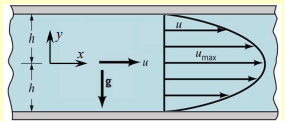A classic problem is the steady, viscous, incompressible flow between two infinite parallel plates, driven by a pressure gradient. The plates are fixed, and no-slip boundary conditions apply.

Assumptions:
- Steady flow
- Incompressible
- Only flow in direction, such that
Recall that the differential form of the continuity equation for incompressible fluids gives
Since we only have flow in the -direction, this simplifies to
This means that is independent of , such that .
Each component of the Navier-Stokes Equations for Incompressible Flows can be analyzed individually under the assumptions:

We can solve for the velocity profile from the -component above:
Integrating once:
Integrating again:
To solve for the constant, we can apply boundary conditions where at (no-slip condition) at both plates.
At :
At :
Solving these simultaneously gives and . Thus:
This is a parabolic velocity profile symmetric about the centerline.
The maximum velocity occurs at :
where the average velocity is given by
So:
Volumetric flow rate (per unit length in the -direction):
If the pressure drop over a length is , then:
Hence:
The pressure field can be found as:
where is the reference pressure.